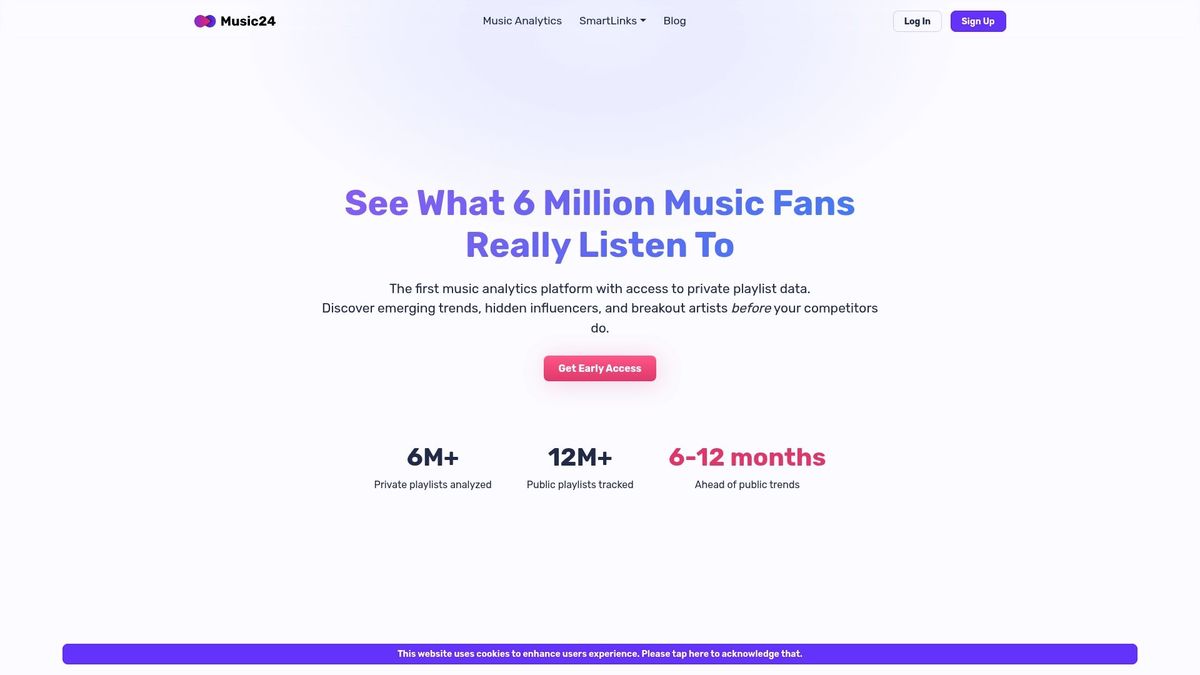Playlist data sounds like just a way to line up songs and hit play. Yet the numbers behind this story are almost hidden in plain sight. A single playlist placement can boost an artist’s daily followers by nearly 1 percent and that's only the beginning. What surprises people most is that playlists are actually powerful data engines shaping music trends, not just background noise for your commute.
Table of Contents
- Defining Playlist Data: What It Is
- The Importance of Playlist Data in Music Strategy
- How Playlist Data Works: Algorithms and Insights
- Key Concepts: Metrics, Trends, and Analytics
- Real-World Applications of Playlist Data in the Industry
Quick Summary
| Takeaway | Explanation |
|---|---|
| Playlist data drives music strategy | Understanding playlist dynamics is crucial for data-driven decisions in the music industry. |
| Engagement metrics reveal listener preferences | Metrics such as play count and skip rate provide insights into audience behavior and interests. |
| Algorithmic insights enhance playlist accuracy | Advanced algorithms analyze musical relationships to improve personalized music recommendations. |
| Data aids in talent identification | Organizations can discover emerging artists by tracking playlist inclusion and engagement metrics. |
| Targeted marketing increases audience engagement | Utilizing detailed listener data allows for precise marketing strategies that resonate with specific demographics. |
Defining Playlist Data: What It Is
Playlist data represents a structured collection of digital audio or video tracks organized in a specific sequence and enriched with contextual metadata. Unlike traditional music compilations, modern playlist data encompasses far more than just a simple list of songs. Playlist insights reveal complex information about listener preferences, musical connections, and emerging trends.
The Fundamental Components of Playlist Data
At its core, playlist data includes several critical elements that transform a basic song collection into a rich informational resource:
- Track Information: Detailed metadata about each song including artist, genre, release date, and audio characteristics
- Sequence and Order: The strategic arrangement of tracks which reveals listener curation patterns
- User Interaction Metrics: Engagement data such as play count, skip rate, and total listening duration
According to research from arXiv, playlist data extends beyond mere song listings. The Melon Playlist Dataset demonstrates how comprehensive playlist metadata can include intricate details like mood tags, thematic connections, and cross-genre relationships.
The following table summarizes the fundamental components of playlist data, organizing the main elements and describing their roles in transforming basic song collections into actionable data resources.
| Component | Description |
|---|---|
| Track Information | Metadata about each song, such as artist, genre, release date, and audio characteristics |
| Sequence and Order | The arrangement of tracks that reveals listener curation patterns |
| User Interaction Metrics | Data including play count, skip rate, and total listening duration |
| Mood Tags | Labels that capture emotional tone or vibe of tracks |
| Thematic Connections | Metadata describing the playlist's themes or conceptual links between songs |
| Cross-Genre Relationships | Information on how tracks blend or interact across different musical genres |
Understanding Playlist Data Complexity
Playlist data is not a static artifact but a dynamic representation of musical discovery and listener behavior. Professional music analysts understand that each playlist tells a unique story about musical preferences, cultural trends, and emerging artist connections.
The complexity of playlist data lies in its multidimensional nature. A single playlist can simultaneously represent personal taste, regional music trends, emotional states, and potential breakthrough artist opportunities. Music industry professionals leverage these nuanced datasets to predict listener behavior, design targeted marketing strategies, and identify potential hit tracks before they become mainstream.
The Importance of Playlist Data in Music Strategy
Playlist data has transformed from a simple collection of songs into a strategic intelligence tool that enables music industry professionals to make sophisticated, data-driven decisions. Modern music strategy now fundamentally depends on understanding playlist dynamics and utilizing these insights for targeted artist development, marketing, and audience engagement.
Strategic Decision Making Through Playlist Metrics
Music industry professionals leverage playlist data to uncover critical insights that go far beyond traditional metrics. Release tracking helps organizations understand how playlists influence artist visibility and audience reception. The strategic value of playlist data emerges through several key analytical dimensions
 :
:
- Artist Discovery: Identifying emerging talent through playlist inclusion patterns
- Audience Segmentation: Understanding listener preferences across different demographics
- Genre Evolution: Tracking musical trends and cross-genre collaborations
According to marketing research from ACM, playlist placement can significantly impact an artist's visibility. A strategic inclusion on a prominent playlist can increase daily followers by nearly 1%, demonstrating the profound influence of playlist curation.
Predictive Analytics and Audience Engagement
Playlist data serves as a predictive tool that allows music industry professionals to anticipate listener behavior and market trends. By analyzing playlist composition, sequence, and user interaction metrics, organizations can develop sophisticated strategies for artist promotion, marketing campaigns, and audience targeting.
The true power of playlist data lies in its ability to provide granular insights into listener preferences. Each playlist represents a complex narrative of musical taste, cultural trends, and emotional connectivity. Music strategists who can decode these narratives gain a significant competitive advantage in understanding and predicting audience engagement patterns.

How Playlist Data Works: Algorithms and Insights
Playlist data algorithms transform raw musical information into sophisticated predictive models that decode listener behavior and musical preferences. These complex computational systems analyze multiple data points to create intelligent, adaptive recommendations that go far beyond simple song matching.
Algorithmic Foundations of Playlist Generation
Playlist generation algorithms leverage multiple computational techniques to understand musical relationships and user preferences.
These systems typically integrate several key analytical approaches:
This table compares three primary playlist generation algorithm approaches discussed in the article, highlighting their analytical methods and the key information each one leverages for effective recommendations.
| Approach | Analytical Method | Key Information Utilized |
|---|---|---|
| Collaborative Filtering | Recommends based on similarities between listener profiles | User listening history, shared preferences |
| Content-Based Filtering | Analyzes musical attributes to suggest similar tracks | Genre, tempo, emotional tone, audio traits |
| Contextual Learning | Considers situational factors and listener behavior dynamically | Time, mood, activity, user context |
- Collaborative Filtering: Recommending songs based on similarities between listener profiles
- Content-Based Filtering: Analyzing musical attributes like genre, tempo, and emotional tone
- Contextual Learning: Understanding listener behavior through time, mood, and activity contexts
According to research published in International Journal of Information Science, advanced recommender systems now combine multiple filtering techniques to enhance playlist accuracy and user satisfaction.
Machine Learning and Predictive Playlist Modeling
Modern playlist algorithms employ sophisticated machine learning models that continuously adapt and improve their recommendations. These intelligent systems analyze complex musical ecosystems, tracking intricate relationships between songs, artists, and listener interactions.
The computational process involves deep neural networks that can recognize subtle musical connections invisible to human curators. By processing thousands of playlist variations, these algorithms develop nuanced understanding of musical taste clusters and emerging genre trends. Music technology insights reveal that these systems can predict listener preferences with remarkable precision, transforming how music is discovered and experienced.
Key Concepts: Metrics, Trends, and Analytics
Playlist data analytics represent a sophisticated ecosystem of quantitative and qualitative measurements that transform raw musical information into actionable strategic insights. These metrics go beyond simple numerical tracking, offering comprehensive perspectives on listener behavior, artistic evolution, and industry dynamics.
Core Performance Metrics in Playlist Analysis
Playlist analytics encompass multiple critical performance indicators that music industry professionals use to understand audience engagement and musical trends:
- Listener Retention Rate: Measuring how long users continue listening to a playlist
- Skip Frequency: Tracking the number of times listeners skip tracks within a playlist
- Cross-Genre Interaction: Analyzing how listeners move between different musical styles
Music technology platforms enable professionals to dive deep into these nuanced metrics, providing unprecedented visibility into listener preferences and emerging musical patterns.
Trend Identification and Predictive Modeling
Advanced playlist analytics leverage sophisticated algorithms to identify emerging musical trends before they become mainstream. These predictive models analyze complex interaction patterns, detecting subtle shifts in listener preferences across different demographic segments.
According to research from EDUCAUSE, effective analytics services can transform raw data into strategic insights. In the context of playlist data, this means understanding not just what listeners are hearing, but how they are experiencing and interacting with music across various platforms and contexts.
Real-World Applications of Playlist Data in the Industry
Playlist data has transformed from a passive listening tool into a strategic asset that drives decision making across multiple sectors of the music industry. Organizations now leverage these sophisticated insights to make precise, data-driven choices about artist development, marketing strategies, and audience engagement.
Strategic Artist Development and Talent Identification
Modern record labels and artist management teams utilize playlist data as a critical mechanism for discovering and nurturing emerging talent. By analyzing playlist inclusion patterns, engagement metrics, and listener behaviors, professionals can:
- Identify Emerging Artists: Track musicians gaining organic traction across different playlist ecosystems
- Understand Genre Transitions: Analyze how artists successfully navigate between musical styles
- Predict Breakthrough Potential: Evaluate an artist's likelihood of mainstream success based on playlist performance
Artist management platforms now integrate playlist data analytics as a core component of talent scouting and development strategies.
Marketing and Audience Engagement Strategies
Playlist data provides unprecedented insights into listener preferences, enabling hyper-targeted marketing approaches. Music industry professionals can now craft precision campaigns that resonate with specific audience segments by understanding intricate listener behaviors.
According to domain expertise research, strategic data utilization allows organizations to move beyond traditional demographic segmentation. By mapping playlist interactions, marketing teams can create narratives that speak directly to listener subcultures, transforming how musical content is promoted and consumed across different platforms.
Unlock Real Music Insights With Music24 Playlist Data Analysis
Are you tired of missing out on the next big trend because you rely only on public playlist charts? This article highlights the hidden value inside complex playlist data—from track sequencing to private listening behaviors—that traditional tools often overlook. Industry leaders who understand the importance of early artist discovery, trend prediction, and authentic listener engagement want real, actionable insights instead of lagging signals from public data.

With Music24.com, you get exclusive access to analytics powered by millions of anonymized private playlists. Our platform uncovers emerging artists, influential tastemakers, and new genre blends weeks before they show up on social feeds or public streaming charts. Experience the difference that predictive, data-driven decision making can make for your label, A&R, or marketing team. Visit the Music24 Playlist Insights page to see how you can stay ahead of the curve or jump directly to Music24.com and unlock the next era of music discovery. Take action now so you are the first to spot industry-changing trends.
Frequently Asked Questions
What is playlist data?
Playlist data refers to a structured collection of digital audio or video tracks organized in a specific sequence, enriched with metadata that provides insights into listener preferences and musical connections.
How do playlist data algorithms work?
Playlist data algorithms analyze various data points, using techniques such as collaborative filtering and content-based filtering, to provide personalized song recommendations based on listening habits and preferences.
Why is playlist data important for music industry professionals?
Playlist data is crucial for music industry professionals as it helps them make informed decisions regarding artist development, marketing strategies, and audience engagement by revealing listener behavior and trends.
What metrics are used to analyze playlist data?
Key metrics in playlist data analysis include listener retention rate, skip frequency, and cross-genre interaction, which collectively offer insights into audience engagement and musical trends.


